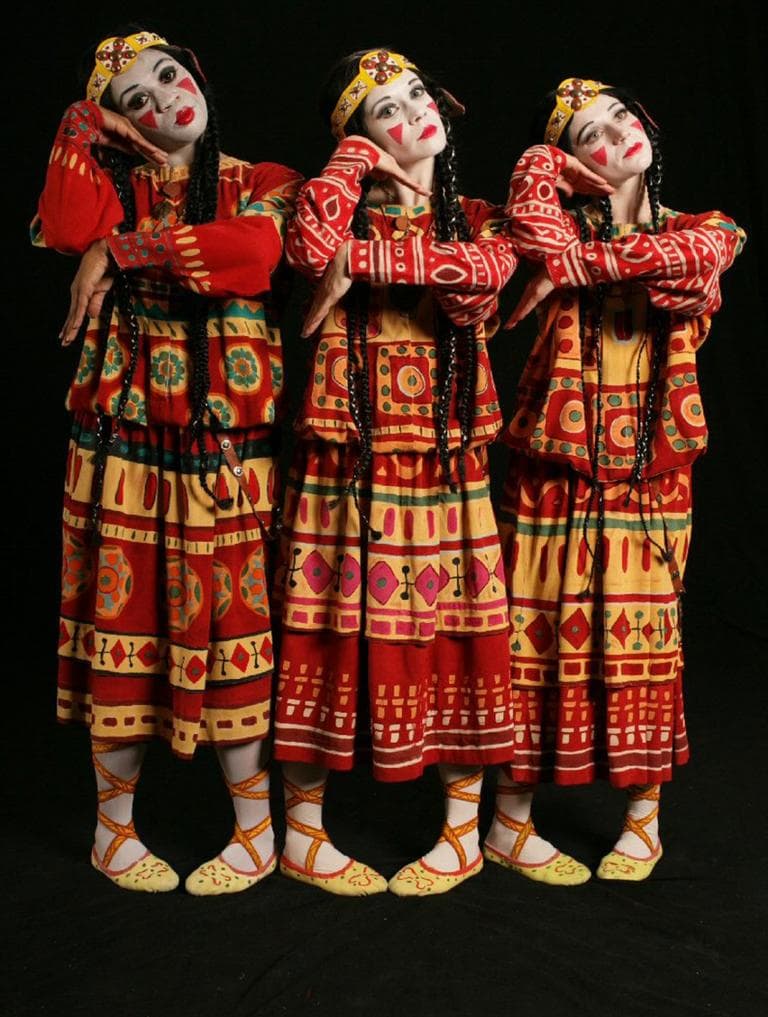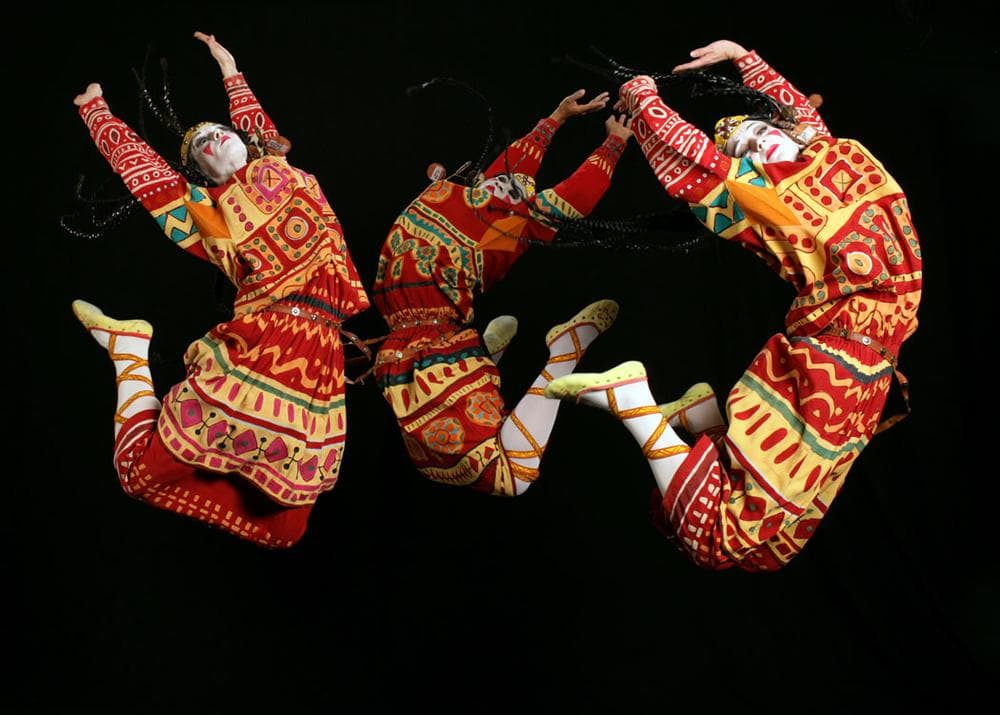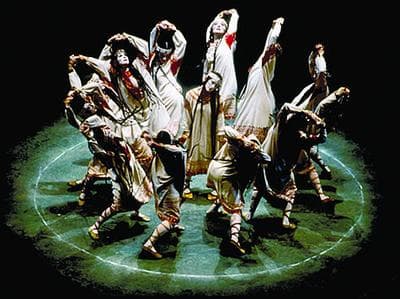Advertisement
A Reconstruction Of 'The Rite Of Spring' As The Infamous Ballet Turns 100
“The Rite of Spring” is a legend, one of the greatest, most infamous succès des scandales of modernist art.
In Paris, on May 29, 1913, a hundred years ago, the Ballets Russes debuted “Le Sacre du Printemps.” From the opening notes of Igor Stravinsky’s score—built not so much on melody, but on wandering horns, epic muscular sweeps, and rumbling drums—audience members shouted and hissed, while others tried to drown them out with applause, recalled Marie Rambert, who assisted choreographer Vaslav Nijinsky with staging the ballet.
It got so loud that the dancers had trouble hearing the music’s rhythm. When the performer playing the lead maiden went into paroxysms as the show neared its climax, hecklers shouted for a doctor and a dentist. Police were called to calm the crowd. But the company performed to the end, and to those open to its force, it was apparent that something new and magnificent had been achieved, a landmark.
Igor Stravinsky’s score quickly became a touchstone of the modernist canon. By 1940, Walt Disney had even included it in his film “Fantasia.” But the ballet it was woven into has become a ghost, a rumor, much talked about but little seen.
So Joffrey Ballet of Chicago's performance of their exclusive North American reconstruction of Nijinsky’s original choreography for “The Rite of Spring” at the Providence Performing Arts Center on March 19, in an event organized by FirstWorks, is a chance to see, finally, what the fuss was all about.
“It’s the hundredth anniversary of a work that was really choreographically lost—because it had so few performances when it was first done, because it was so controversial that it really disappeared,” says Ashley Wheater, who danced with Joffrey when it debuted its reconstructed “Rite” in 1987 and is now the company’s artistic director.

The reconstruction grew out of conversations in 1971 between company founder Robert Joffrey and Millicent Hodson, a choreographer and dance historian and then a graduate student at the University of California at Berkeley, where the Joffrey Ballet was then in residence. It turned out they shared a dream to resurrect “The Rite.”
But it would take her 16 years to piece together Nijinsky’s lost choreography from old notes and drawings, Stravinsky’s rehearsal score, photos, and conversations with people who’d worked with the Ballets Russes like Rambert. During Hodson’s investigation she bumped into art historian Kenneth Archer, who was researching Nicholas Roerich's costumes and sets for the original “Rite.” They ended up marrying—and continuing their research together.
“What they did was a little like excavating,” Wheater says, “taking this line here and this line here and following it through.”
What Hodson and Archer’s reconstruction makes apparent is that Nijinsky’s breakthrough move was to, in effect, do everything wrong.
Advertisement
“It wasn’t in the class of what we typically call ballet,” Wheater says. “It’s all turned in, when ballet is usually turned out.”
Ballet typically involves ignoring the body’s limitations, pretending gravity doesn’t exist. It’s sensual and pretty, with dancing on tiptoes and flowing movement and graceful arching leaps like deer. Nijinsky’s choreography is pigeon-toed and flatfooted and discontinuous. He favors short, jerky staccato jabs and vertical hops, as if the dancers are marionettes. Ballet usually emphasizes the legs and feet. Nijinsky stresses the upper body with big full arm gestures and tableaus created by holding dramatic poses with the arms, torso and head.
“It’s much more on a peasant level,” Wheater says. “It’s not highbrow. It’s groups of people showing rhythm.”
While ballet favors showcases for a handful of lead dancers backed by choruses, Nijinsky focuses almost exclusively on kaleidoscoping group movements like a proto Busby Berkeley. (Could the Russian Nijinsky’s focus on groups here be some sort of precursor to the Russian Revolution that would arrive in 1917?) Instead of the usual revealing tutus, Roerich paints the dancers’ faces like masks and costumes them in baggy tunics that hide their shapely bodies.
“They’re almost unisex for the men and the women,” Wheater notes.

The show itself is a fantasy of a primitive Russian pagan ritual. (Here in the United States many viewers detect clichés of Native American ritual, but Wheater says there are no references to American tribes in Nijinsky’s notes.) As a story, it’s simplistic melodramatic hokum, culminating in a maiden who emerges from a spinning circle of matching female dancers and holds still for a long time until she finally begins a jittery solo in which she dances herself to (pretend) death as some sort of sacrificial ritual. This romantic primitivism is part of what makes the choreography feel dated. Disney’s version featuring dinosaurs facing a global cataclysm in “Fantasia” is a more substantive and complex narrative.

But it’s not the story that powers this ballet, it’s the movement—and stillness. “Once the chosen one has been picked, she stands for an unbelievable amount of time doing nothing. Nobody had ever done that,” Wheater says. “And when she does dance, she just keeps going until the end.”
As reconstituted, “The Rite of Spring” still feels strikingly different and strange, but now also antique. Its radical breakthroughs are today overshadowed and obscured by the pervasiveness of its influence. There’s something both trilling and quaint about it—like George Melies’s pioneering 1902 film fantasy “Voyage to the Moon.”
“The Rite” was only performed eight or nine times in Paris and London during its initial run. Stravinsky’s score took on a life of its own, but the choreography disappeared, a casualty perhaps of the start of World War I, a casualty perhaps of the collapse of Nijinsky’s romantic relationship with Ballets Russes impresario Sergei Diaghilev (Nijinsky married a woman in 1913), a casualty perhaps of Nijinsky’s decline into mental illness which prompted him to give up dancing for all intents and purposes in the late 1910s. Or maybe audiences just didn’t like the choreography enough to sustain it.
“I think still in some ways for some people it’s still controversial. I think by human nature, when we go to the ballet, we assume we’re going to see the ballet,” Wheater says. “What they didn’t expect was this work that went totally against it.”
This article was originally published on March 15, 2013.
This program aired on March 15, 2013. The audio for this program is not available.
